#Tour de France 1949
Text
Geheimen
De paden waar Fausto Coppi over koerste zijn plat getreden. Van de voormalige Campionissimo is dan ook een boekenkast vol geschreven. Deze blog waagt zich daar ook niet aan of het moet deze krabbel in de kantlijn van het wielrennen zijn. Om z’n levenswijze én z’n palmares is de man een cultheld geworden. Ook voor deze blogger die een aantal jaar geleden tijdens een roadtrip door Noord-Italië…
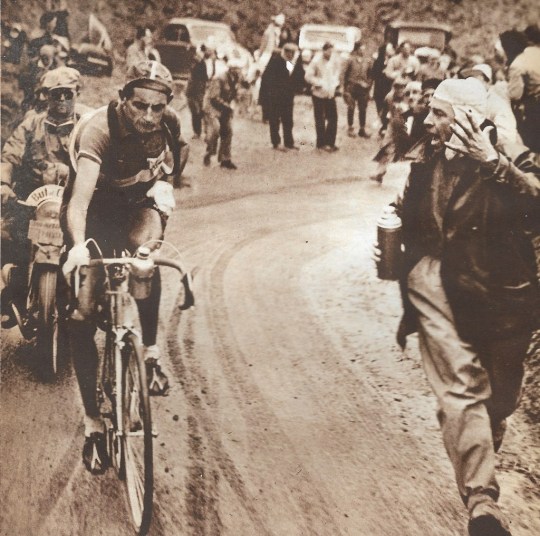
View On WordPress
#Alfredo Binda#Apennijnen#Castallania#Fausto Coppi#Noor-Italie#roadtrip#Tour de France 1949#Tourmalet
1 note
·
View note
Text

Italian Legend
The story of the Campagnolo Gran Sport begins immediately after the Second World War. It was a time when cycle racing was dominated by two Italians - Gino Bartali and Fausto Coppi.
Gino Bartali, a conservative man who saw himself as a skilled craftsman, loved the intricasies and complexities of Tullio Campagnolo's Heath Robinson rod-operated gear changers like the infamous Campagnolo Corsa. He used one to win the 1948 Tour de France.
Fausto Coppi, however, revelled in modernity, progress and technology - and despised Tullio's ornate contraptions. In 1949 Fausto Coppi defected from Campagnolo to Simplex, and horror of horrors, won the Tour de France. An Italian demi-god had triumphed using French equipment. Tullio Campagnolo was humiliated and mortified.
But the shock was exactly what was needed to get the, ever-cautious, Tullio off his backside and spur him to produce, in 1951, his signature Campagnolo Gran Sport derailleur. It, famously, adopted a parallelogram mechanism, and its strength and accuracy defined the way that derailleurs operate up to this very day
Quotation, at length, from Disraeli Gears
#ciclismo#cycling#velo#bike#road cycling#bicycle#bicycling#Campagnolo#Cycling History#Bike Components#Campagnolo Gran Sport#b&w photography#black and white
46 notes
·
View notes
Text
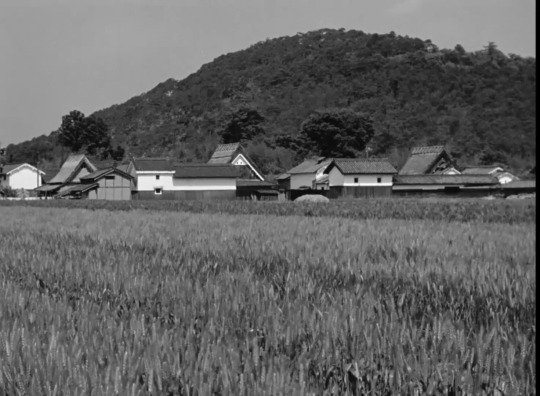
L'approche gurdjiévienne…
Gurdjieff est né en 1877 à Alexandropol, d’un père grec et d’une mère arménienne. Il est mort à Neuilly-sur-Seine, France, en 1949. Gurdjieff était convaincu d'être en mesure de comprendre par lui-même, le sens et le but de l'existence humaine. Il était désireux de connaître les voies qui permettent à l’homme de développer ce qu'il y a de plus élevé en lui. Pour cela, depuis sa jeunesse il s’est entouré d’un groupe d’hommes et de femmes qui partageaient sa vision et qui se nommait Chercheurs de Vérité. Avec ce groupe et ensuite seul, il recueillait des connaissances ancestrales partout où le menait cette quête.
Toutes les sensations de l’homme, ses impressions, ses émotions, ses pensées, sont divisées en positives et négatives, utiles et nuisibles, nécessaires et superflues, bonnes et mauvaises, plaisantes et déplaisantes.
Les pensées s’opposent aux sentiments. Les impulsions motrices s’opposent à la soif instinctive de tranquillité. Que nos mouvements soient volontaires est une illusion ; en fait, ils sont automatiques. Nos pensées et nos sentiments, eux aussi, sont automatiques.
Et l’automatisme de nos pensées et de nos sentiments est étroitement lié à l’automatisme de nos mouvements. L’un ne peut pas être changé sans l’autre.
L'homme, en son for intérieur, ‘exige’ que tout le monde le prenne pour quelqu'un de remarquable, auquel chacun devrait constamment témoigner respect, estime et admiration, pour son intelligence, sa beauté, son adresse, son humour, sa présence d'esprit, son originalité et toutes ses autres qualités.
Ces ‘exigences’ se fondent à leur tour sur la notion complètement fantastique que les gens ont d'eux-mêmes, ce qui arrive très souvent, même avec des personnes d'apparence très modeste. Quant aux écrivains, acteurs, musiciens, artistes et politiciens, ils sont presque sans exception des malades.
Et de quoi souffrent-ils? Avant tout, d'une extraordinaire opinion d'eux-mêmes, ensuite d'exigences et, enfin, de ‘considération’, c'est-à-dire d'une disposition préalable à s'offenser du moindre manque de compréhension ou d'appréciation.
La liberté signifie avant tout : se libérer de l'identification .
L’identification est notre plus terrible ennemi parce qu'elle pénètre partout. Au moment même où nous croyons lutter contre elle, nous sommes encore son dupe. Et s'il nous est si difficile de nous libérer de l'identification, c'est que nous nous identifions plus facilement aux choses qui nous intéressent davantage, celles auxquelles nous donnons notre temps, notre travail et notre attention.
Pour se libérer de l'identification, l'homme doit donc être constamment sur ses gardes et impitoyable envers lui-même. C'est-à-dire qu'il ne doit pas avoir peur de démasquer toutes ses formes subtiles et cachées Selon Georges Ivanovitch Gurdjieff.
2 notes
·
View notes
Text
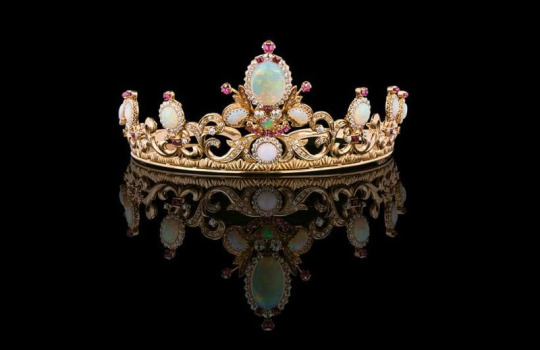

Muriel, Marquise de Chambrun wearing the tiara.
An extremely rare opal tiara from the family of the Late Jean Pierre François Joseph Pineton de Chambrun, Marquis de Chambrun, Marquis d'Amefreville (1903-2004) and his second wife Muriel.
LONDON.- Dreweatts will offer an extremely rare opal tiara from the family of the Late Jean Pierre François Joseph Pineton de Chambrun, Marquis de Chambrun, Marquis d'Amefreville (1903-2004) and his second wife Muriel, Marquise de Chambrun. Jean Pierre Pineton was the eldest son of French politician and diplomat Charles Louis Antoine Pierre Gilbert Pineton de Chambrun (1865-1954) and his American wife, Margaret Rives Nichols (1872-1949). Jean Pierre married his second wife Muriel in married in 1963 and they spent their 40-year marriage between France, the United States and the Algarve in Portugal.
The de Chambrun family has a prominent history as French politicians in the French Senate and French Chamber of Deputies and were direct descendants of Gilbert du Motier, Marquis de Lafayette (1757-1834), the French aristocrat and army officer who commanded American troops to victory in the American War of Independence. He was also a key figure in the French Revolution in 1789 and the July Revolution of 1830 and served in French parliament. Such was his impact that he was considered a national hero in both countries and gained the title of ‘Hero of Two Worlds’.
Jean Pierre and Muriel toured America lecturing about Lafayette and his role in the American Revolution and War of independence. Muriel also became a celebrated poetess and won several awards including Ohio Poet of the year in 1976 for her book of poems Sudden Spring and an award from Cincinnati University in 1970 for her first book Salisbury Cathedral. Jean Pierre and Muriel were fêted by American society and acknowledged by several American President's including Ronald Reagan, Bill Clinton and George Bush Junior for their work in promoting Franco-American relations.
Although profoundly deaf, Jean Pierre had studied biochemistry at the Institut Pasteur, and art at the Horace Vernet school. As a member of at the Cercle de l'Union Artistique in France, Jean Pierre became an acclaimed painter and designer of jewellery, wrought iron and crystal for the renowned firm Baccarat. With his background in jewellery, it is thought that the tiara was most probably designed by him. The tiara is exceptionally rare as it is set with opals, hardly ever seen in period tiaras, due to the stone’s fragility and also as some believed that opals held a strange power, that could bring bad luck to its wearer. This superstition was picked up in the British press, however it was eventually dismissed after it was a firm favourite with Queen Victoria, who during her reign owned multiple pieces of jewellery set with opals, which were said to have been the favourite gemstone of her husband, Prince Albert.
“To have a period tiara set with opals is extremely rare, as the opal stone is so fragile, with their composition mainly consisting of water and silica gel”, says Deputy Chairman and International Head of Jewellery, Silver and Watches at Dreweatts. “Of the very few other tiaras set with opals, is the Princess Marie of Denmark opal tiara, an exuberant Art Nouveau creation of large, towering opal set floral sprays. It has not been seen being worn in public since the wedding of King Harald V and Queen Sonja of Norway in 1968.”
The tiara in the sale is an exuberant piece of mid-20th century jewellery design. Opals are highly attractive stones due to their colour play, as they show all the colours of the rainbow. When rotated in light, one can see different flashes of colour, which are caused by the microscopic silica spheres in the stone. The most sought-after colours are red and green. Opals were traditionally found in Eastern Europe, in the Czech Republic and Slovakia. However, in the 1870s, they were discovered in Australia. Since then Australia has contributed to around 90% of the global output of precious opals. The best opals are found in Lightning Ridge, with others come from Queensland and New South Wales. A small percentage of stones also come from Ethiopia, America and Mexico, however these are not as commercially viable as the Australian examples.
The opals found in this stunning tiara are of exceptional quality and we can therefore assume that these originated from Australia.” says James Nicholson. They are set into 18 carat gold scrolled framework, complimented by circular cabochon, circular cut and step cut ruby accents, as well as rose cut and old mine cut diamonds, adding an extra sparkle. Adding to the uniqueness of this particular tiara, it is intended to be worn more like an ‘alice band’ across the middle of the head, rather than at the front. This adds significant height to it, making it a fabulous statement piece.
Courtesy Alain Truong
10 notes
·
View notes
Text
Famous Five Art Nostalgia #08 – Part 2
Introductory post
Part 1
In this post, you will find the set of illustrations that featured in the special “Idéal Bibliothèque” collection.
Five Get into Trouble – Le Club des Cinq en péril
Original publication date: 1949 (UK), 1957 (France)
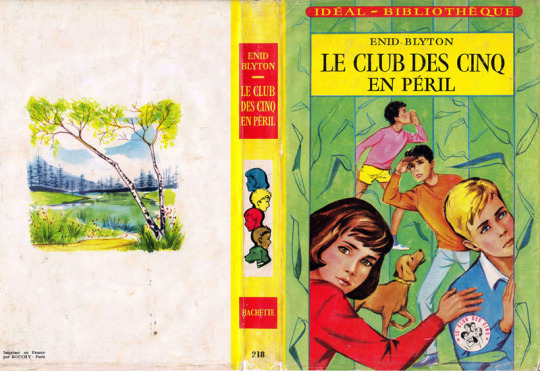
(Full cover by Jeanne Hives, 1962)
Plot summary (adapted from Wikipedia):
Siblings Julian, Dick and Anne are spending the Easter school holidays at Kirrin Cottage with their cousin Georgina and her dog, Timmy. After George's parents, Quentin and Fanny, depart for some scientific conferences, the Five embark on a cycling and camping holiday.
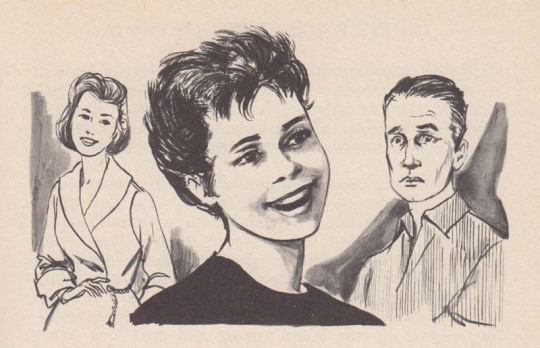
(Uncle Quentin doesn’t always know how to deal with George’s exuberance) [Note: I love this picture of George, she looks so cute!]
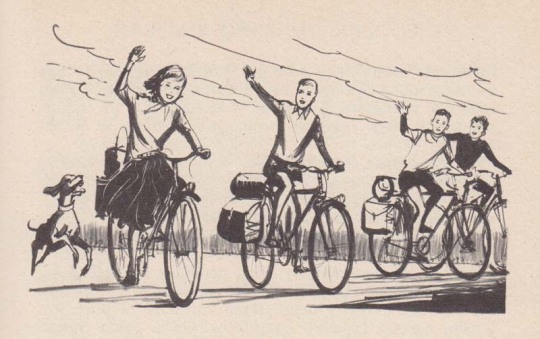
(Onwards to adventure!)
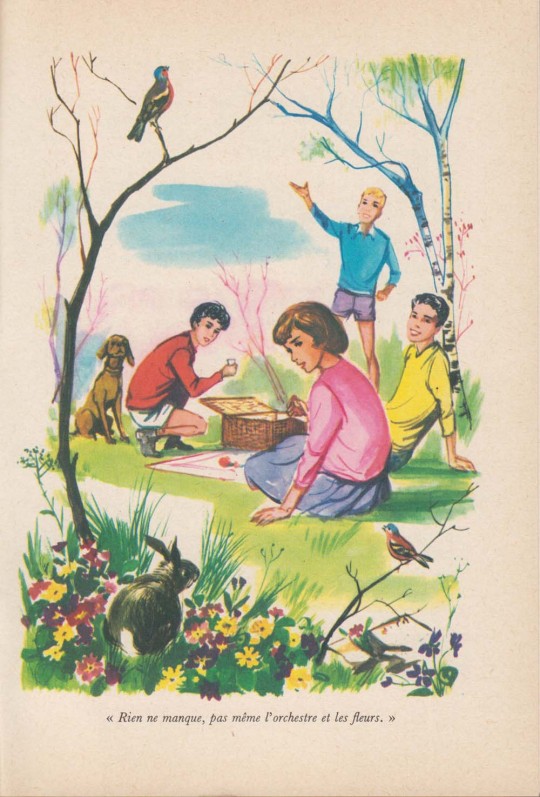
(A pastoral start to the holidays)
At a lake, they encounter a boy named Richard Kent, who wants to spend the day cycling with them. He promises to stay at his aunt's house at the end of the day, if his mother gives him permission. The children agree, and Richard joins them without bothering to request parental permission.

(A refreshing bath at the lake)
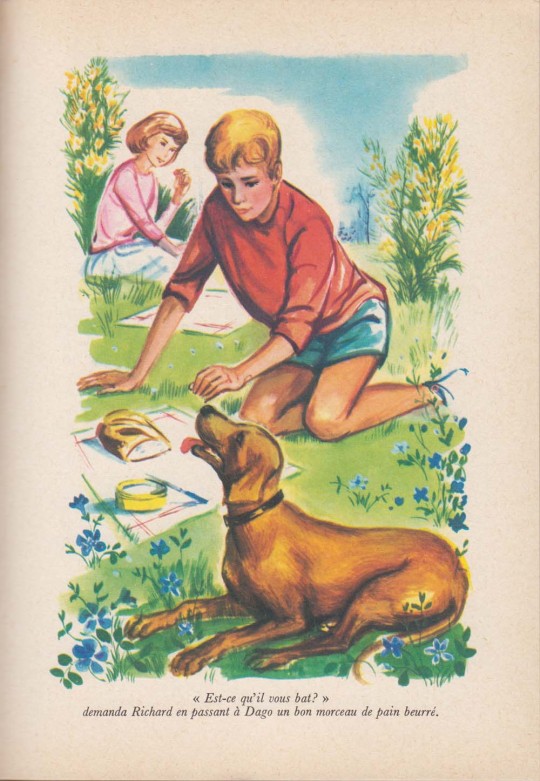
(Sharing breakfast with Richard)
[Note 1: Oh jeez. I couldn’t read the caption on the previous low-quality picture, but Richard is talking with George about their respective short-tempered fathers, and Richard asks, “Does he hurt you?” The implications are bleak. 🙁]
[Note 2: On a lighter note, Richard gives Timmy a piece of bread and butter in the French version, compared to “a nice little tidbit of roll and anchovy paste” in the original text!]
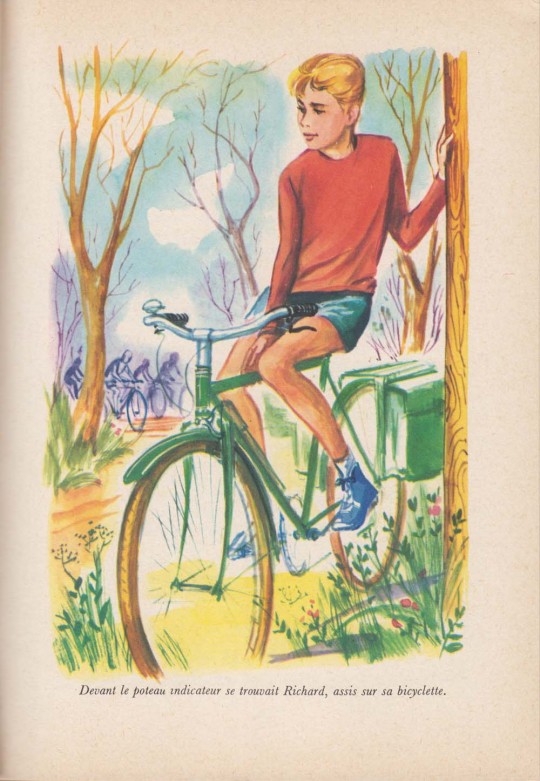
(Richard joins the Five on their cycling tour)
Richard is later chased by a car driven by Rooky, one of his wealthy father's former bodyguards, who was fired because Richard had told tales about him. Rooky's associates chase Richard on foot in Middlecombe Woods, where they mistake Dick for Richard and kidnap him. Richard finds Julian and George, who berate him for his mendacity and cowardice.
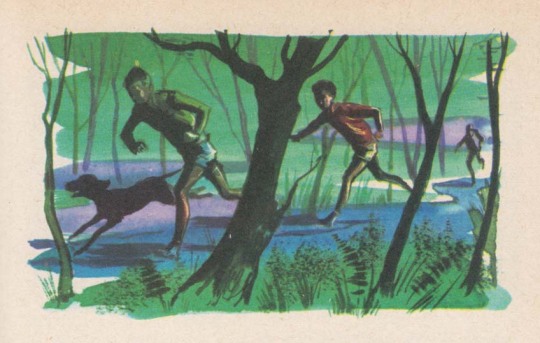
(Timmy, Julian, George, and Richard, lagging behind, hurry back to Dick and Anne)
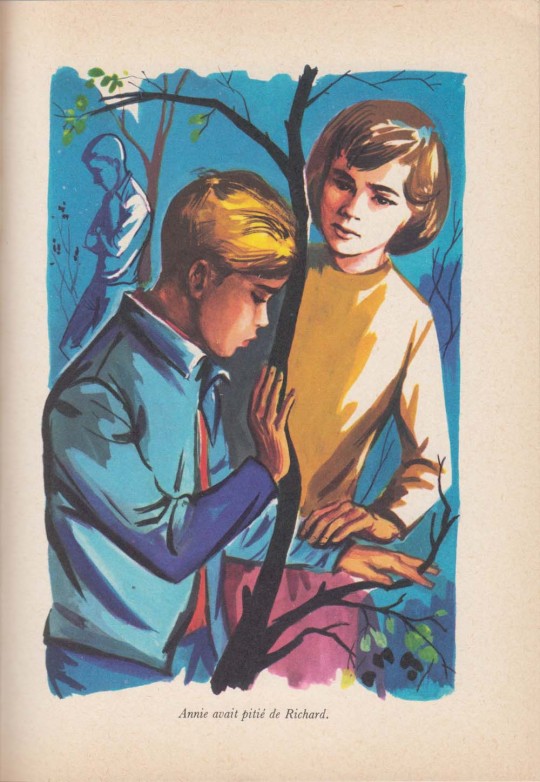
(Richard is ashamed after being berated by George and Julian for his cowardice, but kind-hearted Anne is sympathetic)
The children trace Dick to Owl's Dene, and on the way Julian observes a man changing clothes and another man throwing clothes down a well.

(Strange dealings at night)

(Owl’s Dene’s eponymous guardian)

(The children’s first sight of Owl’s Dene)
At Owl's Dene, the children sneak into the house but are caught and imprisoned, while Timmy remains outside.
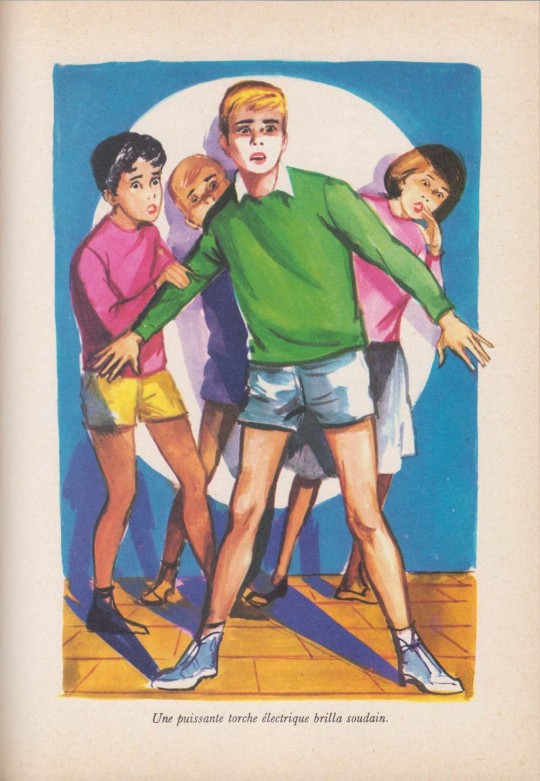
(Caught!)
That night, Julian finds Dick locked in an upstairs room and discovers a secret room with a man sleeping in it.

(A happy reunion despite the tense faces)

(In the morning, Julian makes one of his many delightful quips to a disconcerted Aggie [Margot]. I love how George and Anne just seem to be enjoying the show! 🤣)

(George orders Timmy to stay down while a car enters the grounds; Timmy is Not Pleased)
The next morning, Rooky arrives and sees his associates have kidnapped the wrong boy. The Five and Richard are nearly freed, but Richard is recognised and they are imprisoned in the grounds of the house.
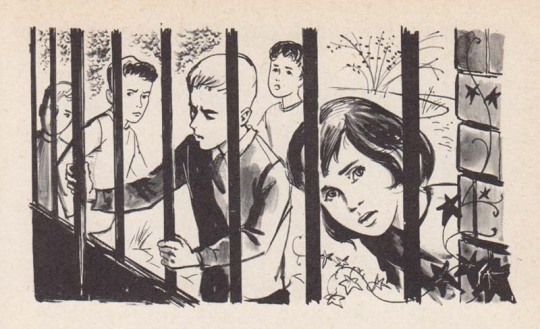
(Trapped on the grounds!)
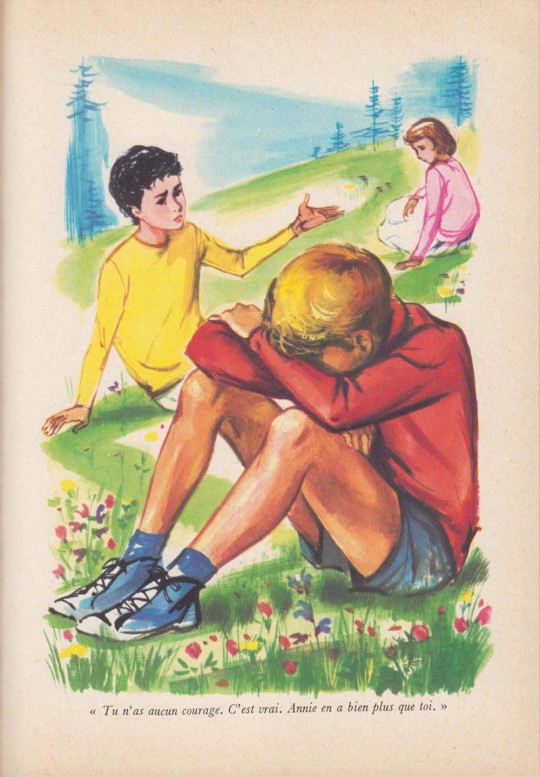
(Richard is shaken after seeing Rooky again, an attitude for which George has no patience at all)

(George feeds the household’s chicken with what Hunchy [La Bosse], one of their captors, believes to be poisoned food intended for Timmy. A well-deserved payback!)
When one of the gang members leaves in their car, Richard hides in the boot, narrowly escapes being recaptured and then goes to the police.
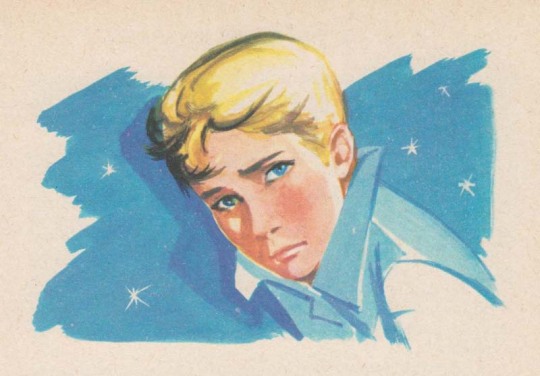
(Richard, with some remaining traces of soot in his hair)

(Richard at the police station)
When the police arrive at Owl's Dene, Julian shows them the secret room containing an escaped convict and stolen diamonds.
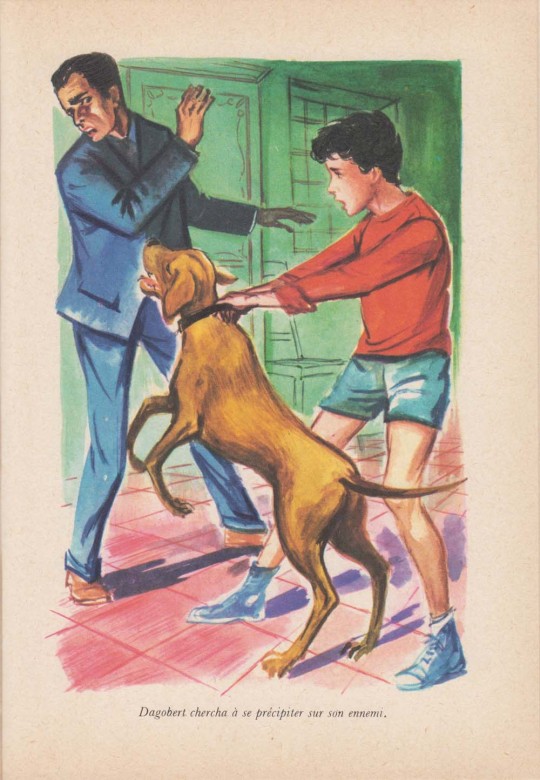
(Final scuffle with the villains)
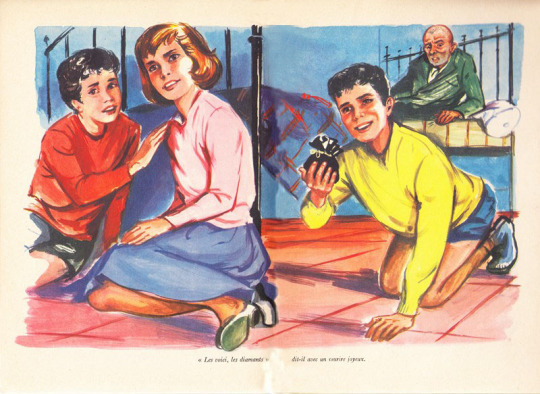
(Dick, Anne and George hide in the secret room along with the escaped convict and retrieve the stolen diamonds)
The Five later join Richard for a meal and praise his heroism.
~~~~~~
Bonus:
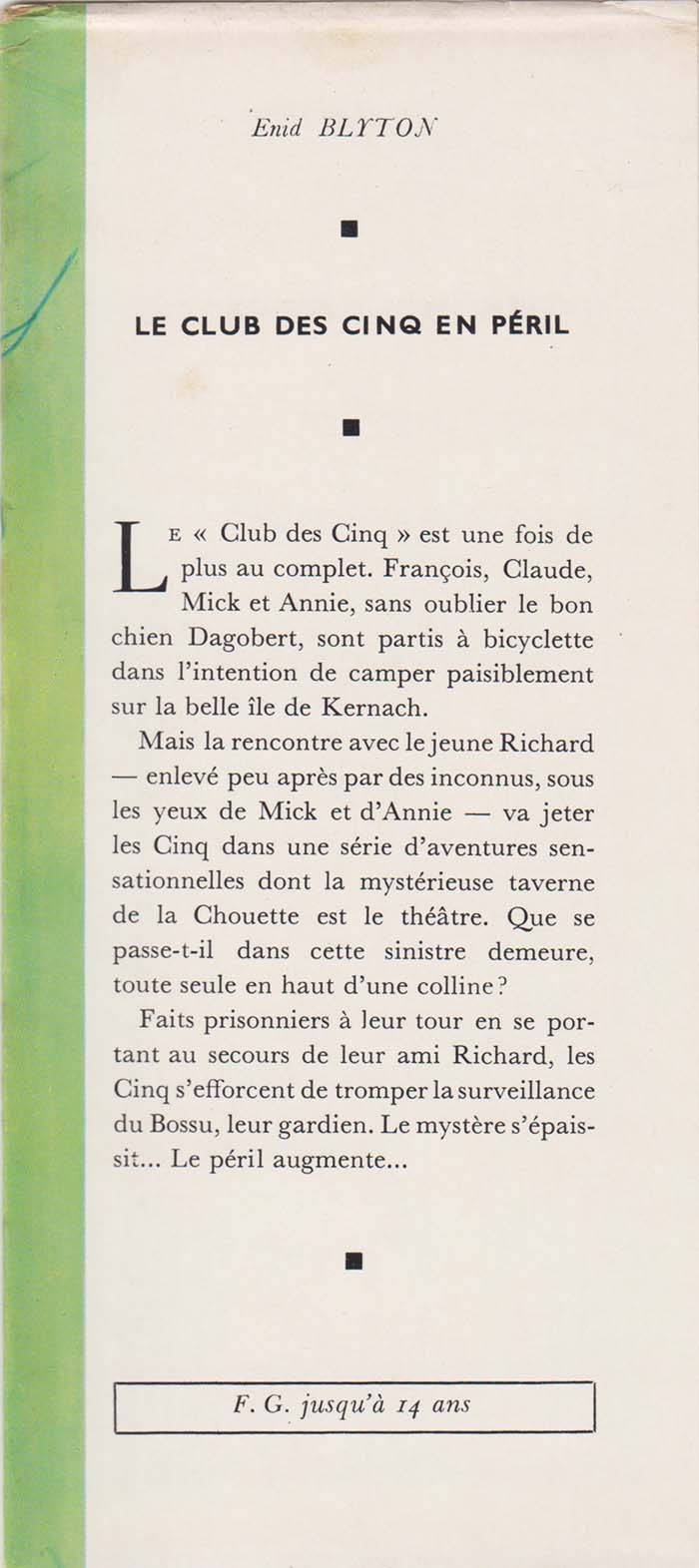
This text appears on the inside of the cover, and gives a teaser for the story… But you’ll see that, for such a short text, it contains a remarkable amount of nonsense:
The first sentence says that the Five are going on a cycling tour to go camping on Kirrin Island. Oh wow, does Kirrin Island have roads now (and a bridge to go there)…? 🤔
The second sentence clearly states that Richard gets kidnapped by strangers in front of Dick and Anne. Sigh… Could these people just maybe leaf through the book to check that what they’re writing is accurate? 😓
The last line indicates the targeted readership. I assume that “F. G.” stands for “filles / garçons”, or “boys and girls.” Okay, fine. What I take issue with is the age limit: “up to 14 years old.” Well, poop on you, I fully intend to read these books well into my 140s! 👻
~~~~~~
Thanks for reading and see you next time!
#papillon82 reads#famous five art nostalgia#famous five#le club des cinq#illustrations#jeanne hives#enid blyton
7 notes
·
View notes
Text
Novembre MMXXIII "November Who"
Films
Dr. Who and the Daleks (1965) de Gordon Flemyng avec Peter Cushing, Roy Castle, Jennie Linden, Roberta Tovey, Barrie Ingham, Michael Coles et Yvonne Antrobus
Ripoux contre ripoux (1990) de Claude Zidi avec Philippe Noiret, Thierry Lhermitte, Guy Marchand, Jean-Pierre Castaldi, Grace de Capitani, Line Renaud, Michel Aumont et Jean Benguigui
Coup de foudre et Conséquences (Fools Rush In) (1997) d'Andy Tennant avec Matthew Perry, Salma Hayek, Jon Tenney, Carlos Gómez, Tomás Milián, Siobhan Fallon et John Bennett Perry
Au-delà des grilles (Le mura di Malapaga) (1949) de René Clément avec Jean Gabin, Isa Miranda, Véra Talchi, Andrea Checchi, Robert Dalban et Ave Ninchi
Clemenceau, la force d'aimer (2023) de Lorraine Lévy avec Pierre Arditi, Emilie Caen, Elizabeth Bourgine, François Marthouret, Serge Riaboukine et Arthur Choisnet
L'Argent des autres (1978) de Christian de Chalonge avec Jean-Louis Trintignant, Catherine Deneuve, Laura et Michèle Kornbluh, Claude Brasseur, Michel Serrault, Gérard Séty et Jean Leuvrais
Mort sur la piste (2023) de Philippe Dajoux avec Jason Priestley, Eléonore Bernheim, Olivier Marchal, Roby Schinasi, Adèle Galloy et Olivia Courbis
Sylvia Scarlett (1935) de George Cukor avec Katharine Hepburn, Cary Grant, Brian Aherne, Edmund Gwenn, Nathalie Paley et Dennie Moore
La Cité sous la mer (City Beneath the Sea) (1953) de Budd Boetticher avec Robert Ryan, Mala Powers, Anthony Quinn, Suzan Ball, George Mathews, Karel Stepanek, Hilo Hattie et Lalo Rios
Second Tour (2023) de Albert Dupontel avec Cécile de France, Albert Dupontel, Nicolas Marié, Scali Delpeyrat, Jackie Berroyer, Christiane Millet, Philippe Uchan, Renaud Van Ruymbeke et Bouli Lanners
Seuls les anges ont des ailes (Only Angels Have Wings) (1939) de Howard Hawks avec Cary Grant, Jean Arthur, Richard Barthelmess, Rita Hayworth, Thomas Mitchell, Allyn Joslyn, Sig Ruman et Victor Kilian
Un pyjama pour deux (Lover Come Back) (1961) de Delbert Mann avec Rock Hudson, Doris Day, Tony Randall, Edie Adams, Jack Oakie, Jack Kruschen, Ann B. Davis : Millie et Joe Flynn
Le Couteau dans la plaie (1962) d'Anatole Litvak avec Sophia Loren, Anthony Perkins, Gig Young, Jean-Pierre Aumont, Régine, Yolande Turner, Tommy Norden, Mathilde Casadesus et Elina Labourdette
Garde à vue (1981) de Claude Miller avec Lino Ventura, Michel Serrault, Romy Schneider, Guy Marchand, Pierre Maguelon, Jean-Claude Penchenat et Elsa Lunghini
La Sanction (The Eiger Sanction) (1975) de Clint Eastwood avec Clint Eastwood, George Kennedy, Vonetta McGee, Jack Cassidy, Heidi Brühl, Thayer David, Reiner Schöne, Michael Grimm et Jean-Pierre Bernard
Deux Hommes dans la ville (1973) de José Giovanni avec Jean Gabin, Alain Delon, Michel Bouquet, Mimsy Farmer, Victor Lanoux, Ilaria Occhini, Guido Alberti, Cécile Vassort, Bernard Giraudeau et Christine Fabréga
JFK (1991) de Oliver Stone avec Kevin Costner, Tommy Lee Jones, Gary Oldman, Kevin Bacon, Laurie Metcalf, Jay O. Sanders, Michael Rooker, Sissy Spacek, Joe Pesci et Jack Lemmon
Le Juge et l'Assassin (1976) de Bertrand Tavernier avec Michel Galabru, Philippe Noiret, Isabelle Huppert, Jean-Claude Brialy, Renée Faure, Cécile Vassort, Yves Robert, Jean-Roger Caussimon et Jean Bretonnière
Le Fugitif (The Fugitive) (1993) d'Andrew Davis avec Harrison Ford, Tommy Lee Jones, Sela Ward, Julianne Moore, Joe Pantoliano, Andreas Katsulas, Jeroen Krabbé et L. Scott Caldwell
Un singe en hiver (1962) de Henri Verneuil avec Jean Gabin, Jean-Paul Belmondo, Suzanne Flon : Suzanne Quentin, Gabrielle Dorziat, Hella Petri, Marcelle Arnold, Charles Bouillaud et Anne-Marie Coffinet
Doctor Who (1996) de Geoffrey Sax avec Sylvester McCoy, Paul McGann, Eric Roberts, Daphne Ashbrook, Yee Jee Tso, John Novak et Michael David Simms
Séries
Doctor Who Saison 19, 20 Series 1, 3, 11, 5, 4
Castrovalva - Four to Doomsday - Kinda - The Visitation - Black Orchid - Rose - La fin du monde - Des morts inassouvis - Earthshock - Time-Flight - Destination: Skaro - Ark of Infinity - La Famille de sang - Smith, la Montre et le Docteur - The Day of the Doctor - Snakedance - The Star Beast - The Ghost Monument - Le Colocataire - La Chute de Pompéi
Top Gear Saison 20
A l'abordage ! - Ils ont roulé sur l'eau - Mission Camping-Car
Brokenwood Saison 8, 5, 4, 3
Quatre incendies et un enterrement - Dix petits héritiers - Tu ne tueras point - Un Noël rouge
Affaires sensibles
Les étonnantes enquêtes du bureau des ovnis - 1975, l'année de la femme - Caravelle Ajaccio-Nice : un crash secret Défense ?
Coffre à Catch
#140 : "Elles répondaient au nom de Bella" (avec Max MK) - #141 : Qui sera le futur Mr Money in the Bank? - #142 : Y'a R les amis!! Y'a R ! - #143 : Tiffany prend les rennes et Finlay prend la Trique !
Happy Days Saison 4
De l'huile sur le feu - Remise des prix : première partie - Remise des prix : deuxième partie - Le Jour J est arrivé - Les Mauvais Garçons - Howard inventeur - Le Chien de Fonzie - Ralphy a de sacrés ennuis - Le Baptême de Fonzie
Downton Abbey Saison 4
La Succession - Lettre posthume - Faste et Renaissance - Le Prétendant - Rien n'est terminé - Une vraie surprise - Dernières Festivités
Professeur T Saison 1
Anatomie d'un souvenir - Un poisson nommé Walter - Règles d'or - L'amour d'une mère - Sophie sait tout - Le fils dévoué
The Crown Saison 6
Persona Non Grata - Deux photographies - Dis-Moi Oui - Onde de choc
Spectacles
Prom 10 : Doctor Who at the Proms (2010) avec Karen Gillan, Arthur Darvill et Matt Smith
Taratata 30 (2023)
La symphonie des jeux vidéos aux Chorégies d'Orange (2021)
Doctor Who at the Proms (2013) avec Neve McIntosh, Dan Starkey, Matt Smith, Jenna Coleman, Carole Ann Ford, Peter Davison, Nicholas Briggs, Ben Foster et Murray Gold
Le vison voyageur (2023) de John Chapman et Ray Cooney avec Michel Fau, Sébastien Castro, Armelle, Nicole Calfan, Anne-Sophie Germanaz, Alexis Driollet, Delphine Beaulieu et Arnaud Pfeiffer
Doctor Who: A Celebration (2006) avec David Tennant, Murray Gold et Russell T Davies
Drôle De Genre (2023) de Jade-Rose Parker avec Victoria Abril, Lionnel Astier, Axel Huet et Jade-Rose Parker
Prom 13: Doctor Who Prom (2008) avec Freema Agyeman, Noel Clarke, Camille Coduri et Catherine Tate
Livres
Doctor Who le dixième docteur, Tome 1 : Les révolutions de la terreur de Elena Casagrande, Nick Abadzis et Arianna Florean
Les contes du vortex de Pepperpot x Friends (Pauline Cadart Serizel, Marie Valerio, Rémi Germain, Robin Brou, Manon Segur, Julien Cadart Serizel, Flavia Valerio et Gökan Martin)
Le docteur Who entre en scène de Terrance Dicks
Doctor Who le dixième docteur, Tome 3 : Les fontaines de l'éternité de Elena Casagrande et Nick Abadzis
Les Daleks de David Whitaker
2 notes
·
View notes
Photo
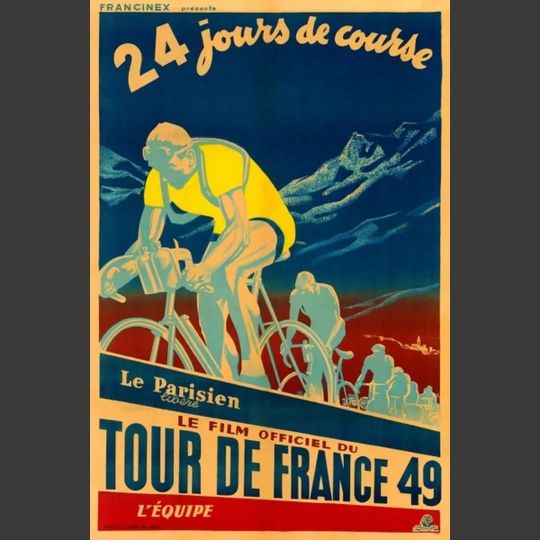
1949 TOUR DE FRANCE POSTER 😀🇫🇷🥐🥖❤️ Available at www.moltenicycling.com #vintagecycling #homedecor #tourdefrancemap #tourdefrance #campagnolo #bianchivintage #brooksofengland #cyclinglife #cyclingdecor #cyclingart #gift #eroica #retrocycling #bicyclemag #cyclingposters #ride #cycling #bicycle #baaw #rideyourbike #cycle #instabike #shimano #cannondale #rapha #cyclist #stravacycling #moltenicycling https://www.instagram.com/p/CpAnrnxrlWt/?igshid=NGJjMDIxMWI=
#vintagecycling#homedecor#tourdefrancemap#tourdefrance#campagnolo#bianchivintage#brooksofengland#cyclinglife#cyclingdecor#cyclingart#gift#eroica#retrocycling#bicyclemag#cyclingposters#ride#cycling#bicycle#baaw#rideyourbike#cycle#instabike#shimano#cannondale#rapha#cyclist#stravacycling#moltenicycling
14 notes
·
View notes
Text

Clotilde von Derp Sakharoff performing in Sulamith, 1944. Unknown photographer. Archivo Editorial Haynes. | MFBA

Clotilde von Derp Sakharoff in Sulamit, 1944. Unknown photographer. Archivo Editorial Haynes. | Museo Nacional de Fotografía de Buenos Aires
"Les Sakharoff" (the name the dancers Alexander Sakharoff and Clotilde von Derp used after their marriage in 1919) toured widely visiting China and Japan, North and South America. They found themselves in Spain when France was invaded by Germany. They returned to South America making a new base in Buenos Aires until 1949.
#clotilde von derp#clotilde von derp sacharoff#clotilde sakharoff#dancer#danseuse#tanzerin#sulamit#sulamith#1940s#editorial haynes#unknown photographer#dance pose#dance costume#tanzpose#tanzkostum
40 notes
·
View notes
Text
Filmography to Love and Adore (1900 - 2022 AD)
1900:
-Joan of Arc
-The One-Man Band
1901:
-History Of A Crime
1902:
-The Coronation of Edward VII
1903:
-Life of An American Fireman
1904:
-The Impossible Voyage
1905:
-Esmerelda
1906:
-The Story of The Kelly Gang
1907:
-L'Enfant Prodigue
1908:
-Dr. Jekyll And Mr. Hyde
-Fantasmagorie
1909:
-Princess Nicotine/The Smoke Fairy
-The Golden Louis
1910:
-Frankenstein
1911:
-Little Nemo
1912:
-The Beautiful Leukanida
1913:
-The Adventures of Kathlyn
1914:
-The Squaw Man
1915:
-Are You A Mason?
-Carmen
-Barnaby Rudge
1916:
-Civilization
-The Mystery of the Leaping Fish
1917:
-Charlie Chaplin: The Cure
1918:
-The Tenth Symphony
1919:
-Intoxication
1920:
-The Saphead
1921:
-L'Atlantide
-Charlie Chaplin: The Kid
1922:
-The Toll of The Sea
1923:
-The Unknown Tomorrow
-The Man in The Iron Mask
1924:
-Dante's Inferno
1925:
-Alfred Hitchcock: The Pleasure Garden
-The Phantom of the Opera
1926:
-The Great Gatsby
-The Devil's Wheel
-The Devil's Circus
-The Golden Butterfly
1927:
-The Jazz Singer
-Alfred Hitchcock: The Lodger (The Story of the London Fog)
-Metropolis
1928:
-Noah's Ark
1929:
-Alfred Hitchcock: Blackmail
-The Broadway Melody
1930:
-Hell's Angels
-Young Man of Manhattan
1931:
-The Man Who Came Back
-Bad Girl
1932:
-Smilin' Through
-Tarzan The Ape Man
-Strange Interlude
1933:
-Little Women
-Gold Diggers of 1933
1934:
-The Lost Patrol
-Riptide
1935:
-Alfred Hitchcock: The 39 Steps
1936:
-Reefer Madness
1937:
-Walt Disney: Snow White & The Seven Dwarfs
-The Good Earth
1938:
-Jezebel
-Alfred Hitchcock: The Lady Vanishes
1939:
-The Wizard of Oz
1940:
-Walt Disney: Pinocchio
-Alfred Hitchcock: Correspondent
-Walt Disney: Fantasia
-Charlie Chaplin: The Great Dictator
-Boom Town
1941:
-Alfred Hitchcock: Suspicion
-Orson Welles: Citizen Kane
1942:
-Casablanca
-Road To Morocco
1943:
-For Whom The Bell Tolls
-Alfred Hitchcock: Shadow of A Doubt
1944:
-Gaslight
-Double Indemnity
-Laura
-National Velvet
1945:
-Alfred Hitchcock: Spellbound
1946:
-The Best Years of Our Lives
-Alfred Hitchcock: Notorious
1947:
-Forever Amber
-The Egg And I
1948:
-The Treasure of the Sierra Madre
-The Search
1949:
-I Married A Communist
-The Man From Colorado
-The Heiress
1950:
-Walt Disney: Cinderella
1951:
-Quo Vadis
-Awaara
-That's My Boy
-The Thirteenth Letter
1952:
-The Big Sky
1953:
-The Robe
-Walt Disney: Peter Pan
1954:
-Magnificent Obsession
-Godzilla
1955:
-Sissi
-The Man With The Golden Arm
1956:
-Francis In The Haunted House
-And God Created Woman
-Anastasia
-The Rainmaker
1957:
-The Bridge on the River Kwai
-Yellow Crow
1958:
-Gigi
-The Defiant Ones
-I Want To Live!
1959:
-Ben-Hur
-The 400 Blows
1960:
-Mughal-E-Azam
1961:
-The Misfits
1962:
-The Manchurian Candidate
-Sundays and Cybéle
-Francis Ford Coppola: The Bellboy & The Playgirls
1963:
-Nurse On Wheels
-Shock Corridor
1964:
-The Beatles: A Hard Day's Night
-Mary Poppins
-Becket
-My Fair Lady
-Seven Days in May
-The Time Travelers
1965:
-The Sound of Music
-The Beatles: Help!
-The Spy Who Came in From The Cold
-The Shop on Main Street
1966:
-A Man for All Seasons
-Roman Polanski: Cul-de-sac
-La Battaglia di Algeri
1967:
-The Graduate
-The Beatles: Magical Mystery Tour
1968:
-Psych-Out!
-Stanley Kubrick: 2001 A Space Odyssey
-The Girl on A Motorcycle
-Roman Polanski: Rosemary's Baby
-Candy
-Wild In The Streets
1969:
-The Night of the Following Day
-Psychout for Murder
-Medium Cool
-The Arrangement
-Easy Rider
1970:
-Donkey Skin
-I Drink Your Blood
-Night Slaves
-Patton
1971:
-Harold and Maude
-Billy Jack
-Stanley Kubrick: A Clockwork Orange
-Frank Zappa: 200 Motels
-Dirty Harry
1972:
-Francis Ford Coppola: The Godfather
-Slaughterhouse-Five
1973:
-The Hourglass Sanatorium
-The Crazies
-American Graffiti
1974:
-Francis Ford Coppola: The Conversation
1975:
-Satanico Pandemonium
1976:
-Martin Scorsese: Taxi Driver
1977:
-Rituals
-Blue Sunshine
1978:
-Deathsport
1979:
-Mad Max
-Francis Ford Coppola: Apocalypse Now
1980:
-Star Wars V: The Empire Strikes Back
-The Exterminator
-Stanley Kubrick: The Shining
-Altered States
-The Octagon
1981:
-Christiane F.
1982:
-Silent Rage
1983:
-Star Wars VI: Return of The Jedi
1984:
-This is Spinal Tap
-Dune
-The Killing Fields
-Red Dawn
1985:
-The Emerald Forest
-Invasion U.S.A.
1986:
-Gus Van Sant: Mala Noche
-What Every Frenchwoman Wants
-Platoon
1987:
-The Girl
1988:
-Zombi 3
-Brain Damage
1989:
-Drugstore Cowboy
1990:
-Hardware
-Jacob's Ladder
-Les 1001 Nuits
1991:
-Oliver Stone: The Doors
-Richard Linklater: Slacker
1992:
-Batman Returns
1993:
-In The Name of The Father
-12:01
1994:
-The Stand
-The Crow
-Leon The Professional
-Pulp Fiction
1995:
-Before Sunrise
-The Basketball Diaries
-Billy Madison
1996:
-Mike Judge: Beavis And Butthead Do America
-Wes Anderson: Bottle Rocket
-Beautiful Girls
-Mission Impossible
1997:
-Conspiracy Theory
-Harmony Korine: Gummo
-Lost Highway
1998:
-The Truman Show
-Fear And Loathing In Las Vegas
-The Big Lebowski
-Wes Anderson: Rushmore
-Vincent Gallo: Buffalo 66
1999:
-Stanley Kubrick: Eyes Wide Shut
-Fight Club
-The Matrix
-American Beauty
-The Blair Witch Project
2000:
-American Psycho
-Mission Impossible II
-Scary Movie
2001:
-Studio Ghibli: Spirited Away
-Wes Anderson: The Royal Tenenbaums
2002:
-Star Wars II: Attack of the Clones
-Damon Packard: Reflections of Evil
-Demonlover
-Equilibrium
-Panic Room
-Spun
2003:
-The League of Extraordinary Gentlemen
-Oldboy
-Just Married
-Vincent Gallo: The Brown Bunny
-Party Monster
-Gus Van Sant: Elephant
2004:
-Before Sunset
-Fahrenheit 9/11
-The Day After Tomorrow
2005:
-Gus Van Sant: Last Days
2006:
-Jet Li: Fearless
-Candy
-Children of Men
-Little Miss Sunshine
-The Science of Sleep
2007:
-Hot Rod
2008:
-Tropic Thunder
-Batman: The Dark Knight
-Robot Chicken: Star Wars Episode II
-The Love Guru
-Be Kind Rewind
-Gonzo: The Life And Work of Dr. Hunter S. Thompson
2009:
-The Imaginarium of Dr. Parnassus
-Harmony Korine: Trash Humpers
-Enter The Void
-Zombieland
-District 9
-We Live In Public
2010:
-My Joy
2011:
-The Sitter
-Drive
2012:
-Dredd
-Crystal Fairy & The Magic Cactus
-Jim Gaffigan: Mr Universe Standup Comedy
-Artificial Paradises
-Cloud Atlas
-Batman: The Dark Knight Rises
2013:
-A Field In England
-3096 Days
2014:
-Saint Laurent
2015:
-The Road
2016:
-The Love Witch
-Dernieres Nouvelles Du Cosmos (Latest News From The Cosmos)
2017:
-Low Life
2018:
-Mandy
-Waco
-Climax
2019:
-Joker
-1917
-Once Upon a Time In Hollywood
2020:
-Borealis
2021:
-Fear And Loathing in Aspen
-The Beatles/Peter Jackson: Get Back
-Juice WRLD: Into The Abyss
2022:
-Everything Everywhere All At Once
23 notes
·
View notes
Text
4 July 2023
These Green Fields of France
Paris
4 July 2023
On the 1st of July 1916, a thousand tragedies played out in a thousand places. It seems monstrous to classify them as ‘better’ or ‘worse’ than any other, but perhaps one of the saddest stories of the entire war happened at Beaumont Hamel, a short distance from Thiepval and Pozieres. It was here that the 29th Division, fresh from the horrors of Gallipoli, attacked. Among them were the Royal Newfoundland Regiment.
In the early 20th Century, the modern Canadian provinces of Newfoundland and Labrador were their own nation - the Dominion of Newfoundland. Their population was small, but they managed to raise a battalion - the so-called ‘Blue Puttees’ - to fight in France. They’d diverted to Suvla Bay on the way, but now the 780 active officers and men had reached the Somme, ready to take part in Britain’s largest push of the war. These men did not consider themselves Canadian - they were Newfoundlanders and proud of it, and likely had more bond with the British of the 29th, who had shared the experience of Gallipoli, than their neighbours in the CEF.
That July morning, the 29th’s attack, like most divisions on the northern and central parts of the Somme front, was meeting with disaster. The 86th and 87th Brigades were bogged down before the German wire, and the GOC, Major-General De Lisle, had no way of knowing precisely what was becoming of his men. Reports came in that British troops had apparently broken through - if so, they needed support. De Lisle committed the 88th Brigade, the Newfoundlanders amongst them.
The British trenches were so clogged with the dead and wounded that the regiment was forced to go over the top from a support trench 250m behind the British front line. As they emerged, they were suddenly the only moving troops visible to the Germans - all of the enemy’s fire fell upon them. Ahead in No Man’s Land was the ‘Danger Tree,’ a skeletal husk that was meant to be used as a way point, towards which the Blue Puttees now headed. Unfortunately, the Danger Tree was known to the Germans, who had the area presited for artillery.
As far as I’m aware, none of the Newfoundlanders made it anywhere near the German line. It was the Nek played out in France, but drawn out and - incredibly - even worse. Of the 22 officers and 758 men of the Blue Puttees that set out that day, only 68 were present at roll call the next day. When General De Lisle reviewed the situation, he made a poignant, perhaps even somewhat self-critical, remark - “It was a magnificent display of trained and disciplined valour, and its assault only failed of success because dead men can advance no further.” Only one battalion - the 10th West Yorkshires - suffered worse casualties.
Newfoundland never recovered. The high casualties, combined with the Great Depression and political scandals, led to the revokation of responsible government in the 1930s and the absorption of Newfoundland into Canada in 1949. 1st July, for most Canadians, is Canada Day, but for the people of Newfoundland and Labrador, it remains a day of mourning. It’s a graphic reminder of how war can destroy not only men’s lives and bodies, but the hopes and dreams of whole peoples.

We left Amiens at 8.30 for our last battlefield tour - it feels like years since we first scaled Plugge’s Plateau. Our first stop was the Querrie British Cemetery. I had reached the point by then where I felt entirely numb to cemeteries; even the most intimate of epitaphs failed to get through an emotional weariness created by seeing grave after grave after grave. I was hit a little by one discovery - in this cemetery for the men of the war to end all wars, there’s a British pilot shot down during the Battle of France in 1940. But even then, that was a moment of pause rather than an emotion - a brief moment to say ‘huh’ rather then anything deep and moving. I thought there was no more the Western Front could give me.
Next we went to Pozieres Windmill (after swinging past Albert for photos of the famous tower), which I’ve visited before. I still like the area - the memorial to the Tank Corps is across the road, so I stopped to look at that before following the group to the Windmill. The first thing you’ll notice about the Windmill is the lack of a windmill - there was one, once, but it was blasted apart by artillery during the ferocious battles on 1916. This is the place that Charles Bean described as being ‘more densely sown with Australian blood than any other place on Earth.’ In six weeks, as many Australians died as during the whole Gallipoli campaign.

When I last came here, there was a field of little hand-made crosses dotting the field beyond the craters. You could walk straight out there and stand amongst them - and to the WWI Animals Memorial, which is behind the Windmill. No more. A hedge blocks the way now, as if the Animals Memorial is too vulgar to share space with the Windmill site, and the crosses have been cleared away. Instead there’s a Hollywood Sign styled collection of words dominating the view from the tallest crater, screeching ‘POZIERES 1916 LEST WE FORGET’ at the viewer, and beyond that a carefully manicured bed of roses. I know not who did this, but it feels like the initiative of a Big Man - the Mayor, perhaps, or the DVA - thrusting aside the small, thoughtful memorials of the peasantry to make his own statement. So often this seems to be the case - be it Howard and Abbott’s hundred million dollar baby under the graves at Villers-Bretonneux, or the carefully choreographed dawn services at Anzac that replaces the small ones at the Beach Cemetaries. Memorial culture is dotted with Big Men with Big Ideas and Big Egos, and I think the world would be a better place if they left things well enough alone.

The caretakers of the battlefield at Beaumont Hamel did precisely that.
There were three artificial things I found at Beaumont Hamel, excluding the footpaths that allowed the visitor to navigate the site. The first was a small museum, basically built in a cabin that sits out of the way. The second is the big caribou monument built in the 1920s, the giant animal facing into No Man’s Land as if calling the souls of the dead home. Finally, there’s a modest replica of the Danger Tree installed to give visitors an idea of where it was. Otherwise, the battlefield, bought by the Newfoundland government and now owned by the Canadians, is left as it was for nature to reclaim. The shell holes and trenches remain, but they’re covered in grass now, and there’s patches of forest and trees. The Beaumont Hamel battlefield has returned to the Earth from whence it came, and I found that my capacity to care had not been exhausted after all.
Standing next to the site of the Danger Tree, staring out into No Man’s Land, thinking of the futile deaths of hundreds of men, and hearing the distant sound of birdsong and feeling the warm sun, I felt the urge to shout out at the sheer folly of it all, to forcibly drag the group, who I felt weren’t appreciating the site possible, to the cemetery beyond to read the names. How could you stand here and not feel? How could you still talk and laugh and joke about small nothings in a place like this?
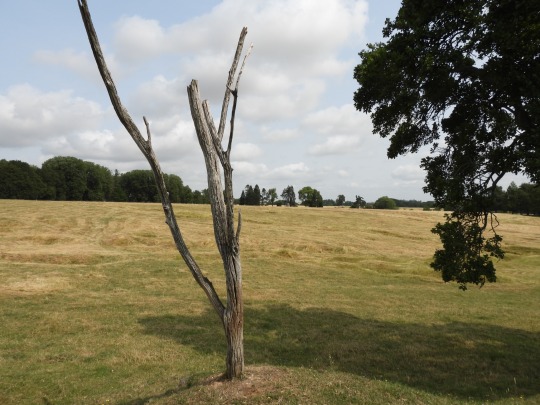
But then I talked to Maddi, and she gave me a different perspective. Of course they laugh and joke. That’s how they process going to cemetery after cemetery after cemetery. People react to confronting sites differently, and just because I might think someone’s being disrespectful doesn’t mean they are - or at least not intentionally. I think they laugh and joke about things happening in the world today for the same reason I started to go numb - because if you focused on all the grief and loss we’ve seen this past few weeks, if you made yourself feel every bit of it, you’d go mad. And did I not laugh at the Sir John Monash Centre, sitting as I was under the graves? Who am I to criticise them? Did not the soldiers I was thinking about use black humour to cope with their situations?
People are strange, and I sometimes have trouble really understanding them. I think every does, but some are better at hiding their puzzlement at humanity.

We stopped at Ulster Tower to eat in their cafe, but they weren’t serving food so we cut our losses and ate at a service station near Albert. We then went back out to Thiepval.
The Thiepval Memorial was once described as a structure consisting of ‘deranged arches,’ and that critique isn’t entirely wrong, but I’ve always found it strangely beautiful - more so than the more famous Menin Gate. This discordant memorial, situated in the middle of the most beautiful part of northern France, lists the names of the missing of the Somme; British and French. I don’t know what the group discussed here, because I walked up the steps alone. I found a name for a family member, then stepped up to stand under the central arch, where the stone reading ‘their name liveth forever more’ resides. From here, you can see the cemetery - French to the left, British to the right, the Cross of Sacrifice between them.

I walked down there. Normally I’d walk among the graves, looking for interesting epitaphs, but this time I just sat down in front of the unknown soldiers and, as Eric Bogle’s famous song goes, sat for a while ‘neath the warm summer sun. Just me and him, whoever he was.
There is no such thing as a necessary war - even when you’re fighting to defend yourself or someone else, you’re doing so because somebody attacked you. There is no glory, and fundamentally no point, in trying to achieve political goals through military might. All those great ‘heroes’ of conquest - Alexander, Caesar, Napoleon - I find them contemptous. War is young men - kids, even - dying for old men. It is violent, it is grotesque, and any statesman who would consider it anything more than an absolute last resort isn’t worth their salt.
There’s heroism in war, I will say that - the fighter pilots of the Battle of Britain, the Allied troops who stormed Normandy, the stretcher bearers who risked life and limb to save others. Mostly it’s just killing and dying. I can’t look at the Newfoundlanders, or the men at the Nek, or Bullecourt, or Chemin des Dames or Passchendaele or a thousand other stories of military failure across history - and say they ‘sacrificed’ for us. They died for nothing. They didn’t shorten the war by a single second. They didn’t die for our freedom. The only way we can make these deaths mean something - anything at all - is to endeavour never to let waste like this happen again. To research their histories, to tell their stories, to reveal everything warts and all, and hope and pray that the lesson will stick.
Maybe one day we’ll learn.

We’re in Paris now - our last teaching exercise is tomorrow. I’m filled with a sense of melancholy, but at the same time relief. I think I’m about ready to step out of the front line.
3 notes
·
View notes
Text
Dominique Darbois
Dominique Darbois (1925-2014) was the daughter of a major specialist of Asian arts and a novelist. She participated in the Free French Forces during the Second World War in 1941. Being a member of the resistance and Jewish, she was arrested and imprisoned at the Drancy camp for two years. In 1944, she continued to fight against the occupiers and received the Resistance Medal. In 1945 France was liberated and Darbois left for Indochina via Shanghai. Although she was only twenty, she had already lived several lives. After the war ended, she came back to France and became the assistant of the French photographer Pierre Jahan, which prompted her career as a photographer.
In 1951, she organized an expedition to Amazonia and Guyana with Francis Mazière and Wladimir Ivanov, from which originated four publications: “Parana le petit Indien” (1952), “Les Indiens d’Amazonie” (1954), “Mission Tumuc-Humac” (1954), “Yanamalé village of the Amazon”. The first publication was translated into eight languages. She then began the collection "Enfants du monde” [Children of the world], a series of twenty volumes containing images and texts by Darbois herself. This collection offered a world tour not from an ethnographic standpoint but rather as a photographer committed to meet children in a world where not everyone was born equal. She surveyed over fifty countries.
If she spent only a few days in Mongolia in 1957, she actually stayed much longer in China during the Hundred Flowers period [during which the Communist Party encouraged its citizens to openly express their opinions of the communist regime]. Thanks to the French photojournalist Henri Cartier-Bresson – who photographed the last days of the political party Kuomintang in 1949 – she obtained a visa only a few people would get at that time. She accompanied an archaeological expedition that led her to photograph the Maijishan Grottoes in Gansu province as well as the Gobi Desert. She captured daily life in both cities and the countryside, while seizing traditions: acrobatics, games of chance, operas, puppets shows… and the new oil refineries around Lanzhou, oil wells around Yumen, political posters, and even the lives of prisoners in labour camps.
In 1960 she published “Les Algériens en guerre” [Algerian at war]. She completed reportage on the maquis and the training camps of the National Liberation Front [the socialist political party in Algeria] in Tunisia. This reportage was forbidden in France. Darbois was interested in the moving world and in ancient civilizations. She published “Kaboul, le passé confisqué. Trésors du musée de Kaboul, 1931-1965” [Kabul, the confiscated past. Treasures of the Kabul Museum, 1931-1965] (2002).
While she could have put aside her cameras, started to manage her archives, once again she committed herself to women in France and in Africa. She published then “Afrique, terre de femmes” [Africa, land of women] (2004) and “Terre d’enfants” [Children's Land] (2004), with a text written by Pierre Amrouche. This was her ultimate work
Written by Françoise Denoyelle

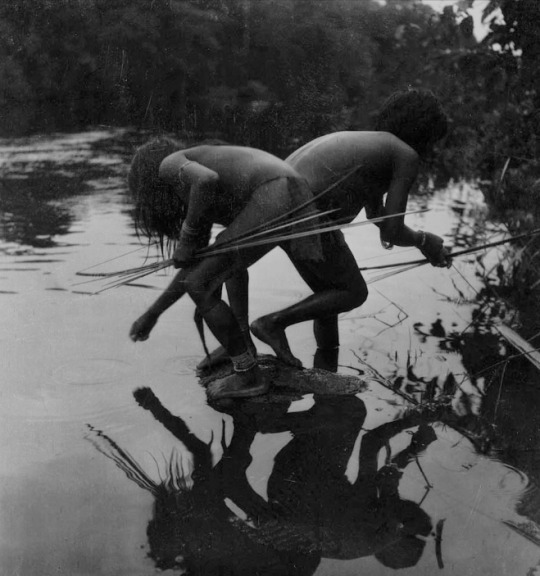
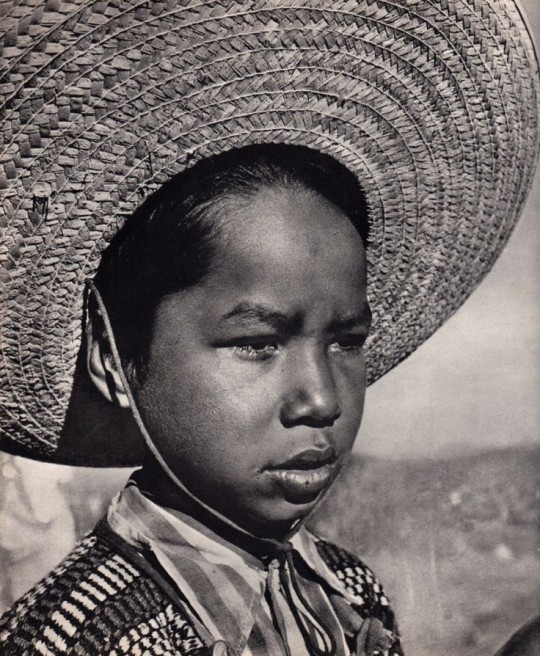







#dominique darbois#photography#culture#art collective#art#photomagazine#london#bnwphotography#photojournalism#female photographers
5 notes
·
View notes
Text

youtube
Dreweatts is delighted to offer an extremely rare opal tiara from the family of the Late Jean Pierre François Joseph Pineton de Chambrun, Marquis de Chambrun, Marquis d’Amefreville (1903-2004) and his second wife Muriel, Marquise de Chambrun. Jean Pierre Pineton was the eldest son of French politician and diplomat Charles Louis Antoine Pierre Gilbert Pineton de Chambrun (1865-1954) and his American wife, Margaret Rives Nichols (1872-1949). Jean Pierre married his second wife Muriel in married in 1963 and they spent their 40-year marriage between France, the United States and the Algarve in Portugal.
The de Chambrun family has a prominent history as French politicians in the French Senate and French Chamber of Deputies and were direct descendants of Gilbert du Motier, Marquis de Lafayette (1757-1834), the French aristocrat and army officer who commanded American troops to victory in the American War of Independence. He was also a key figure in the French Revolution in 1789 and the July Revolution of 1830 and served in French parliament. Such was his impact that he was considered a national hero in both countries and gained the title of ‘Hero of Two Worlds’.
Jean Pierre and Muriel toured America lecturing about Lafayette and his role in the American Revolution and War of independence. Muriel also became a celebrated poetess and won several awards including Ohio Poet of the year in 1976 for her book of poems Sudden Spring and an award from Cincinnati University in 1970 for her first book Salisbury Cathedral. Jean Pierre and Muriel were fêted by American society and acknowledged by several American President’s including Ronald Reagan, Bill Clinton and George Bush Junior for their work in promoting Franco-American relations.
Although profoundly deaf, Jean Pierre had studied biochemistry at the Institut Pasteur, and art at the Horace Vernet school. As a member of at the Cercle de l’Union Artistique in France, Jean Pierre became an acclaimed painter and designer of jewellery, wrought iron and crystal for the renowned firm Baccarat. With his background in jewellery, it is thought that the tiara was most probably designed by him. The tiara is exceptionally rare as it is set with opals, hardly ever seen in period tiaras, due to the stone’s fragility and also as some believed that opals held a strange power, that could bring bad luck to its wearer. This superstition was picked up in the British press, however it was eventually dismissed after it was a firm favourite with Queen Victoria, who during her reign owned multiple pieces of jewellery set with opals, which were said to have been the favourite gemstone of her husband, Prince Albert.
“To have a period tiara set with opals is extremely rare, as the opal stone is so fragile, with their composition mainly consisting of water and silica gel”, says Deputy Chairman and International Head of Jewellery, Silver and Watches at Dreweatts. “Of the very few other tiaras set with opals, is the Princess Marie of Denmark opal tiara, an exuberant Art Nouveau creation of large, towering opal set floral sprays. It has not been seen being worn in public since the wedding of King Harald V and Queen Sonja of Norway in 1968.”
The tiara in the sale is an exuberant piece of mid-20th century jewellery design. Opals are highly attractive stones due to their colour play, as they show all the colours of the rainbow. When rotated in light, one can see different flashes of colour, which are caused by the microscopic silica spheres in the stone. The most sought-after colours are red and green. Opals were traditionally found in Eastern Europe, in the Czech Republic and Slovakia. However, in the 1870s, they were discovered in Australia. Since then Australia has contributed to around 90% of the global output of precious opals. The best opals are found in Lightning Ridge, with others come from Queensland and New South Wales. A small percentage of stones also come from Ethiopia, America and Mexico, however these are not as commercially viable as the Australian examples.
“The opals found in this stunning tiara are of exceptional quality and we can therefore assume that these originated from Australia.” says James Nicholson. They are set into 18 carat gold scrolled framework, complimented by circular cabochon, circular cut and step cut ruby accents, as well as rose cut and old mine cut diamonds, adding an extra sparkle. Adding to the uniqueness of this particular tiara, it is intended to be worn more like an ‘alice band’ across the middle of the head, rather than at the front. This adds significant height to it, making it a fabulous statement piece. It is estimated to fetch of £12,000-£18,000 when it goes under the hammer in Dreweatts Fine Jewellery, Silver Watches and Object of Vertu sale on March 22, 2023.
Opal tiaras are extremely rare, and only one other tiara set with opals is known. The Princess Marie of Denmark opal tiara was an exuberant Art Nouveau creation of large, towering opal set floral sprays. The tiara was re-set by Princess Marie's daughter-in-law Princess Viggo, into a simpler diadem. This opal diadem was passed down to the Count and Countess Flemming of Rosenborg, and has not been seen being worn in public since it was last worn at the wedding of King Harald V and Queen Sonja of Norway in 1968.
The present lot is an exuberant piece of mid 20th century jewellery design. Although unmarked, it is probably made in Northern Italy, and with his background in jewellery, it is likely that it was designed by Jean Pierre.
Opals are rarely found in tiaras due to the fragility of the stone, with their composition mainly made up of water and silica gel. They are highly prized due to their colour play, showing all the colours of the rainbow. When rotated in light, one can see different flashes of colour, which are caused by the microscopic silica spheres in the stone. The most sought after colours are red and green.
Opals were traditionally found in Eastern Europe, in the Czech Republic and Slovakia. However, in the 1870s, they were discovered in Australia. Since then Australia has contributed to around 90% of the global output of precious opals. The best opals are found in Lightning Ridge, with others coming from Queensland and New South Wales. A small percentage of stones also come from Ethiopia, America and Mexico, however these are not as commercially viable as the Australian examples.
The opals found in the present lot are of exceptional quality, and so we can be fairly certain that these originated from Australia. They are set into 18 carat gold scrolled framework, complimented by circular cabochon, circular cut and step cut ruby accents, as well as rose cut and old mine cut diamonds, adding an extra sparkle.Adding to the uniqueness of this tiara, it is intended to be worn more like an alice band across the middle of the head, rather than at the front. This adds significant height to it, making it a real statement piece.
4 notes
·
View notes
Text
Birthdays 7.30
Beer Birthdays
Hamar Alfred Bass (1842)
Leopold Nathan (1864)
Tom Peters (1953)
Peter Cogan (1962)
Dr. Bill Sysak (1962)
Dean Biersch
Jim Jacobs (1963)
Five Favorite Birthdays
Kate Bush; English pop singer (1958)
Buddy Guy; blues guitarist, singer (1936)
Richard Linklater; film director (1960)
Jean Reno; Moroccan-French actor (1948)
Thorstein Veblen; economist (1857)
Famous Birthdays
Paul Anka; pop singer, songwriter (1941)
Duck Baker; guitarist (1949)
Simon Baker; Australian actor, director (1969)
Henry W. Bloch; H&R Block founder (1922)
Ron Block; singer-songwriter and banjo player (1964)
Peter Bogdanovich; film director (1939)
Marc Bolan; rock singer (1947)
Emily Bronte: English writer (1818)
Alton Brown; chef, television host (1962)
Delta Burke; actor (1956)
Smedley Butler; U.S. Marines major general (1881)
Princess Clémentine of Belgium (1872)
Frances de la Tour; English actress (1944)
Dean Edwards; comedian (1970)
Laurence Fishburne; actor (1961)
Henry Ford; car manufacturer (1863)
Kerry Fox; New Zealand actress (1966)
Vivica A. Fox; actor (1964)
Craig Gannon; English guitarist and songwriter (1966)
Tom Green; Canadian comedian and actor (1971)
Jeffrey Hammond; English bass player (1946)
Anita Hill; law professor, victim (1956)
Sid Krofft; Canadian-American puppeteer (1929)
Lisa Kudrow; actor (1963)
Soraida Martinez; painter (1956)
Christine McGuire; pop singer (1929)
Patrick Modiano; French novelist (1945)
Henry Moore; artist, sculptor (1898)
Sean Moore; Welsh drummer and songwriter (1968)
Chris Mullin; basketball player (1963)
Christopher Nolan; English-American film director (1970)
Salvador Novo; Mexican poet and playwright (1904)
Ken Olin; actor (1954)
Pollyanna Pickering; English environmentalist and painter (1942)
Jaime Pressly; actor (1977)
Samuel Rogers; English writer (1763)
David Sanborn; saxophonist (1945)
Rat Scabies, English drummer (1955)
Arnold Schwarzenegger; Austrian-born body builder, actor (1947)
Hope Solo; soccer player (1981)
Frank Stallone; singer-songwriter and actor 91950)
Stan Stennett; Welsh actor and trumpet player (1925)
Casey Stengel; baseball manager (1891)
Hilary Swank; actor (1974)
Otis Taylor; singer-songwriter and guitarist (1948)
Alexander Trocchi; Scottish author and poet (1925)
Giorgio Vasari; Italian painter (1511)
Dick "Mr. Whipple" Wilson; actor (1916)
Victor Wong; actor (1927)
0 notes

